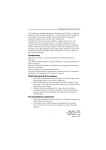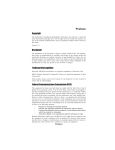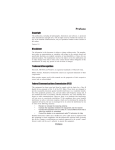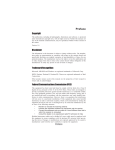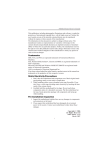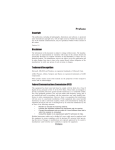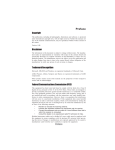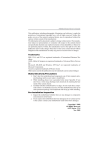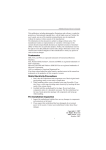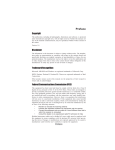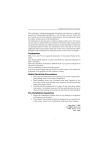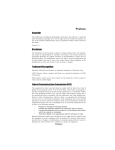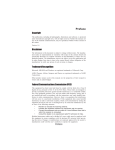Download PC CHIPS P49G (V1.0)
Transcript
Motherboard User’s Guide This publication, including photographs, illustrations and software, is under the protection of international copyright laws, with all rights reserved. Neither this user’s guide, nor any of the material contained herein, may be reproduced without the express written consent of the manufacturer. The information in this document is subject to change without notice. The manufacturer makes no representations or warranties with respect to the contents hereof and specifically disclaims any implied warranties of merchantability or fitness for any particular purpose. Further, the manufacturer reserves the right to revise this publication and to make changes from time to time in the content hereof without obligation of the manufacturer to notify any person of such revision or changes. Trademarks IBM, VGA, and PS/2 are registered trademarks of International Business Machines. MMX, Pentium, Pentium-II, Pentium-III, Celeron are registered trademarks of Intel Corporation. Microsoft, MS-DOS and Windows XP/Vista/7 are registered trademarks of Microsoft Corporation. AMI is a trademark of American Megatrends Inc. It has been acknowledged that other brands or product names in this manual are trademarks or the properties of their respective owners. Static Electricity Precautions 1. Don’t take this motherboard and components out of their original staticproof package until you are ready to install them. 2. While installing, please wear a grounded wrist strap if possible. If you don’t have a wrist strap, discharge static electricity by touching the bare metal of the system chassis. 3. Carefully hold this motherboard by its edges. Do not touch those components unless it is absolutely necessary. Put this motherboard on the top of static-protection package with component side facing up while installing. Pre-Installation Inspection 1. Inspect this motherboard whether there are any damages to components and connectors on the board. 2. If you suspect this motherboard has been damaged, do not connect power to the system. Contact your motherboard vendor about those damages. Copyright © 2009 All Rights Reserved P49G Series, V1.0 December 2009 i Motherboard User’s Guide Table of Contents Trademark ............................................................................................................ i Static Electricity Precautions ......................................................................................... i Pre-Installation Inspection ............................................................................................. i Chapter 1: Introduction ..................................................................................... 1 Key Features .................................................................................................................... 1 Package Contents ........................................................................................................... 4 Chapter 2: Motherboard Installation .............................................................. 5 Motherboard Components ............................................................................................ 6 I/O Ports .......................................................................................................................... 7 Installing the Processor ................................................................................................. 8 Installing Memory Modules .......................................................................................... 9 Jumper Settings ............................................................................................................ 1 3 Install the Motherboard ............................................................................................... 1 5 Connecting Optional Devices ..................................................................................... 1 6 Install Other Devices .................................................................................................... 1 8 Expansion Slots ............................................................................................................ 1 9 Chapter 3: BIOS Setup Utility ....................................................................... 21 Introduction .................................................................................................................. 2 1 Running the Setup Utility ........................................................................................ ...21 Standard CMOS Setup Page ....................................................................................... 2 2 Advanced Setup Page .................................................................................................. 2 4 Advanced Chipset Setup Page .................................................................................... 2 6 Integrated Peripherals Page ....................................................................................... 2 7 Power Management Setup Page ................................................................................. 2 8 PCI/PnP Setup Page .................................................................................................... 2 9 PCI Health Status Page ............................................................................................... 3 0 Frequency/Voltage Control Page ............................................................................... 3 4 Load Default Settings ................................................................................................... 3 5 Supervisor Password Page .......................................................................................... 3 5 User Password Page ..................................................................................................... 3 6 Save & Exit Setup ......................................................................................................... 3 6 Exit Without Saving ...................................................................................................... 3 6 Chapter 4: Software & Applications .............................................................. 37 Introduction .................................................................................................................. 3 7 Installing Support Software ........................................................................................ 3 7 Bundled Software Installation .................................................................................... 3 9 Chapter 5 Trouble Shooting .......................................................................... 40 ii Motherboard User’s Guide Start up problems during assembly..........................................................40 Start up problems after prolong use........................................................41 Maintenance and care tips.....................................................................41 Notice: 1 Owing to Microsoft’s certifying schedule is various to every supplier, we might have some drivers not certified yet by Microsoft. Therefore, it might happen under Windows XP that a dialogue box (shown as below) pop out warning you this software has not passed Windows Logo testing to verify its compatibility with Windows XP. Please rest assured that our RD department has already tested and verified these drivers. Just click the “Continue Anyway” button and go ahead the installation. iii Chapter 1: Introduction Chapter 1 Introduction This motherboard has a LGA775 socket for latest Intel Core 2 Quad*/Intel® CoreTM 2 Duo/Pentium® Dual-Core/Celeron® Dual-Core/Celeron® 400 series processors with Front-Side Bus (FSB) speeds up to 1333/1066 MHz. It integrates Intel®G41 Northbridge and ICH7 Southbridge that supports the Serial ATA interface for high-performance and mainstream desktop PCs. The memory controller supports DDR3 memory DIMM frequencies of 1066/800. It supports two DDR3 sockets with up to maximum memory of 4 GB. The built-in USB 2.0 providing higher bandwidth, implementing USB 2.0 EHCI. It supports High Definition Audio Codec and provides Ultra DMA 100/66/33 function. It has one PCI Expressx16, one PCI Expressx1 and one 32-bit PCI slot. There is a full set of I/O ports including two PS/2 ports for mouse and keyboard, one VGA port, one LAN port, four back-panel USB 2.0 ports and Audio jacks for microphone, line-in and line-out and onboard two USB headers providing extra four ports by connecting the Extended USB Module to the motherboard. It is a Micro ATX motherboard and has power connectors for an ATX power supply. Key Features The key features of this motherboard include: LGA775 Socket Processor • Intel Core 2 Quad*/Intel®CoreTM 2 Duo/Pentium®Dual-Core/Celeron®DualCore/Celeron® 400 series processors • Supports 1333/1066 MHz Front-Side Bus *This board support 65W TDP Core 2 Quad Processors. 1 Motherboard User’s Guide Chipset The Intel® G41 Northbridge (NB) and Intel® ICH7 Southbridge (SB) chipsets are based on an innovative and scalable architecture with proven reliability and performance. • High Performance Host Interface: Supports Intel Core 2 Quad /Intel® CoreTM 2 Duo/Pentium® Dual-Core/Celeron® Dual-Core/Celeron® 400 series processors family with FSB1333/1066 MHz • System Memory Controller Support: DDR3 SDRAM with up to maximum memory of 4 GB. • PCI Express Graphics Interface Support: One PCI Express x16 port • PCI Bus Interface Support: PCI Revision 2.3 Specification at 33MHz • Integrade Serial ATA Host Controller with Data transfer rates up to 3.0 Gb/s • Intgrated IDE Controller: Ultra DMA-100/66/33 Bus Master EIDE Controller • USB 2.0: Integrated USB 2.0 interface, supporting up to eight functional ports Memory Support • Two 240-pin DIMM sockets for DDR3 1333/1066 SDRAM* with Dualchannel architecture. • Maximum installed memory is 4 GB Expansion Slots • One 32-bit PCI slot • One PCI Express x16 slot • One PCI Express x1 slot Onboard IDE channels • One IDE Connector • Supports PIO (Programmable Input/Output) and DMA (Direct Memory Access) modes • Supports IDE Ultra DMA bus mastering with transfer rates of 100/66/ 33 MB/sec Serial ATA • Serial ATA Connector • Transfer rate exceeding best ATA (3.0 Gb/s) with scalability to higher rates • Low pin count for both host and devices * Due to the chipset spec, this motherboard runs at DDR3 1066/800 MHz memory speed. Please refer to the memory QVL in page 11~12. 2 Chapter 1: Introduction Audio • • • • 5.1 Channel High Definition Audio Codec Exceeds Microsoft Windows Logo Program (WLP) Requirements ADCs support 44.1K/48K/96K/192KHz sample rate Power Support: Digital: 3.3V; Analog: 5.0V Onboard LAN (optional) • • • • • • Supports PCI ExpressTM 1.1 Integrated 10/100/1000 transceiver Wake-On-LAN (WOL) and remote wake-up support Supports PCI ExpressTM 1.1 Integrated 10/100 transceiver Wake-On-LAN (WOL) and remote wake-up support Onboard I/O Ports • Two PS/2 ports for mouse and keyboard • One VGA port • One LAN port • Four USB 2.0 ports • Audio jacks for microphone, line-in and line-out BIOS Firmware This motherboard uses AMI BIOS that enables users to configure many system features including the following: • Power management • Wake-up alarms • CPU parameters • CPU and memory timing The firmware can also be used to set parameters for different processor clock speeds. Dimensions • Micro ATX form factor of 225 x 170 mm Note: Hardware specifications and software items are subject to change without notification. 3 Motherboard User’s Guide Package Contents Your motherboard package ships with the following items: The motherboard The User’s Guide Two Serial ATA cables Optional Accessories You can purchase the following optional accessories for this motherboard. The Extended USB module The IDE drive ribbon cable The Serial ATA power cable Note: You can purchase your own optional accessories from the third party, but please contact your local vendor on any issues of the specification and compatibility. 4 Chapter 2: Motherboard Installation Chapter 2 Motherboard Installation To install this motherboard in a system, please follow these instructions in this chapter: Identify the motherboard components Install a CPU Install one or more system memory modules Make sure all jumpers and switches are set correctly Install this motherboard in a system chassis (case) Connect any extension brackets or cables to headers/connectors on the motherboard Install peripheral devices and make the appropriate connections to headers/connectors on the motherboard Note: 1. 2. Before installing this motherboard, make sure jumper CLR_CMOS is under Normal setting. See this chapter for information about locating CLR_CMOS and the setting options. Never connect power to the system during installation; otherwise, it may damage the motherboard. 5 Motherboard User’s Guide Motherboard Components LABEL COMPONENTS LGA775 socket for Intel Core 2 Quad/Intel® CoreTM 2 Duo/ Pentium® Dual-Core/Celeron® Dual-Core/Celeron® 400 series processors 2. CPU_FAN CPU cooling fan connector 3. DDR3_1~2 240-pin DDR3 SDRAM slots 4. ATX_POWER Standard 24-pin ATX power connector 5. IDE Primary IDE channel 6. SPK Speaker header 7. CLR_CMOS Clear CMOS jumper 8. SATA1~2 Serial ATA connectors 9. F_USB1~2 Front panel USB headers 10. USBPWR_F Front panel USB power select jumper 11. LPT Onboard parallel port header 12. SPDIFO SPDIF out header 13. F_PANEL Front panel switch/LED header 14. F_AUDIO Front panel audio header 15. PCI 32-bit add-on card slot 16. COM Onboard serial port header 17. PCIE PCI Express x 1 slot 18. PCIEX16 PCI Express x16 graphics card slot 19. USBPWR_R Rear Panel USB/PS2 Power Select jumper 20. ATX12V 4-pin +12V power connector 6 1. CPU Socket Chapter 2: Motherboard Installation I/O Ports The illustration below shows a side view of the built-in I/O ports on the motherboard. PS/2 Mouse Use the upper PS/2 port to connect a PS/2 pointing device. PS/2 Keyboard Use the low er PS/2 port to connect a PS/2 keyboard. VGA Port Use the VGA port to connect VGA devices. LAN Port Connect an RJ-45 jack to the LAN port to connect your computer to the Netw ork. USB Ports Use the USB ports to connect USB devices. Audio Ports Use these three audio jacks to connect audio devices. The first jack is for stereo Line-In signal, the second jack for stereo Line-Out signal, and the third jack for Microphone. 7 Motherboard User’s Guide Installing the Processor This motherboard has a LGA775 socket for the latest Intel Core 2 Quad/Intel® CoreTM 2 Duo/Pentium® Dual-Core/Celeron® Dual-Core/Celeron® 400 series processors. When choosing a processor, consider the performance requirements of the system. Performance is based on the processor design, the clock speed and system bus frequency of the processor, and the quantity of internal cache memory and external cache memory. CPU Installation Procedure Follow these instructions to install the CPU: A. Read and follow the instructions shown on the sticker on the CPU cap. B. Unload the cap • Use thumb & forefinger to hold the lifting tab of the cap. • Lift the cap up and remove the cap completely from the socket. C. Open the load plate • Use thumb & forefinger to hold the hook of the lever, pushing down and pulling aside unlock it. • Lift up the lever. • Use thumb to open the load plate. Be careful not to touch the contacts. D. Install the CPU on the socket • Orientate CPU package to the socket. Make sure you match triangle marker to pin 1 location. 8 Chapter 2: Motherboard Installation E. Close the load plate • Slightly push down the load plate onto the tongue side, and hook the lever. • CPU is locked completely. F. Apply thermal grease on top of the CPU. G. Fasten the cooling fan supporting base onto the CPU socket on the motherboard. H. Make sure the CPU fan is plugged to the CPU fan connector. Please refer to the CPU cooling fan user’s manual for mor detail installation procedure. Note 1: To achieve better airflow rates and heat dissipation, we suggest that you use a high quality fan with 3800 rpm at least. CPU fan and heatsink installation procedures may vary with the type of CPU fan/ heatsink supplied. The form and size of fan/heatsink may also vary. Note 2: The fan connector supports the CPU cooling fan of 1.1A~2.2A (26.4W max.) at +12V. Note 3: Do Not remove the CPU cap from the socket before installing a CPU. Note 4: Return Material Authorization (RMA) requests will be accepted only if the motherboard comes with the cap on the LGA775 socket. Installing Memory Modules This motherboard accommodates two 240-pin DIMM sockets for unbuffered DDR3 1333/1066 memory modules, and maximum 4 GB installed memory. 9 Motherboard User’s Guide Memory Module Installation Procedure These modules can be installed with up to 4 GB system memory. Refer to the following to install the memory module. 1. Push down the latches on both sides of the DIMM socket. 2. Align the memory module with the socket. There is a notch on the DIMM socket that you can install the DIMM module in the correct direction. Match the cutout on the DIMM module with the notch on the DIMM socket. 3. Install the DIMM module into the socket and press it firmly down until it is seated correctly. The socket latches are levered upwards and latch on to the edges of the DIMM. 4. Install any remaining DIMM modules. 10 Chapter 2: Motherboard Installation Table A: DDR3 (memory module) QVL (Qualified Vendor List) The following DDR3 1333/1066memory modules have been tested and qualified for use with this motherboard. Type Size Vendor 512 MB ELPIDA Module Nam e PC3-8500U-7-00-AP HYMT112U64ZNF8-G8 AA Hynix HMT112U6AFP8C-G7N0 AA Kingston 1 GB DDR3 1066 KVR1066D3N7/1G MT8HTF12864AY-667E1 Micron MT8JTF12864AZ-1G1F1 Ramaxel RMR1810NA48E7F-1066-LF Samsung Gloden Bar M378B2873DZ1-CF8 0818 HYMT125U64ZNF8-G8 AA Hynix 2 GB HMT125U6AFP8C-G7N0 AA MT16JTF25664AZ-1G1F1 Micron MT16JTF25664AY-1G1D1 Samsung M378B5673DZ1-CF8 0842 11 Motherboard User’s Guide Type Size 1 GB Vendor Module Name A-data AD3U1333B1G9-B Hynix HMT112U6AFP8C-H9N0 AA KingMax FLFD45F-B8KG9 NAES Kingston KVR1333D3N9/1G MT8JTF12864AY-1G4D1 Micron MT8JTF12864AZ-1G4F1 PSC AL7F8G73D-DG1 Ramaxel RMR1810KD48E7F-1333 M378B2873DZ1-CH9 Samsung DDR3 1333 2 GB M378B2873EH1-CH9 Silicon Pow er SP001GBLTU133S01 A-data AD3U1333B2G9-B Apacer 78.A1GC6.9L1 Elixir M2F2G64CB8HA4N-CG 0903.TW Hynix HMT125U6AFP8C-H9N0 AA KingMax FLFE85F-B8KG9 NEES Kingston KVR1333D3N9/2G Micron MT16JTF25664AY-1G4D1 PSC AL8F8G73D-DG1 Samsung M378B5673EH1-CH9 Silicon Pow er SP002GBLTU133S01 12 Chapter 2: Motherboard Installation Jumper Settings Connecting two pins with a jumper cap is SHORT; removing a jumper cap from these pins, OPEN. CLR_CMOS: Clear CMOS Jumper Use this jumper to clear the contents of the CMOS memory. You may need to clear the CMOS memory if the settings in the Setup Utility are incorrect and prevent your motherboard from operating. To clear the CMOS memory, disconnect all the power cables from the motherboard and then move the jumper cap into the CLEAR setting for a few seconds. 1 CLR_CMOS Function Jum per Setting Normal Short Pins 1-2 Clear CMOS Short Pins 2-3 Note: To avoid the system unstability after clearing CMOS, we recommend users to enter the main BIOS setting page to “Load Optimal Defaults” and then “Save Changes and Exit”. 13 Motherboard User’s Guide USBPWR_F: FRONT PANEL USB POWER SELECT Jumper 1 USBPWR_F Function VCC 5VSB Jum per Setting Short Pins 1-2 Short Pins 2-3 USBPWR_R: REAR USB PS/2 POWER SELECT Jumper Use this jumper to set the Rear USB PS/2 Power function. 1 USBPWR_R Function VCC 5VSB Jum per Setting Short Pins 1-2 Short Pins 2-3 Note:1. Make sure the power supply provides enough SB5V voltage before selecting the SB5V function. 2. To wake up the computer by USB/PS2 KB/Mouse in S3 status, users have to place the USBPWR_F & USBPWR_R cap onto 2-3 pin instead of 12 as default, and then press into BIOS “Power Management Setup”page to choose the functions (USB/PS2KB/MS) you want to enable. 14 Chapter 2: Motherboard Installation Install the Motherboard Install the motherboard in a system chassis (case). The board is a Micro ATX size motherboard. You can install this motherboard in an ATX case. Make sure your case has an I/O cover plate matching the ports on this motherboard. Install the motherboard in a case. Follow the case manufacturer’s instructions to use the hardware and internal mounting points on the chassis. Connect the power connector from the power supply to the ATX_POWER connector on the motherboard. The ATX12V is a +12V connector for CPU Vcore power. If there is a cooling fan installed in the system chassis, connect the cable from the cooling fan to the CPU_FAN fan power connector on the motherboard. Connect the case switches and indicator LEDs to the F_PANEL header. Here is a list of the F_PANEL pin assignments. Pin 1 3 5 7 9 Signal HD_LED_P(+) HD_LED_N(-) RESET_SW_N(-) RESET_SW_P(+) RSVD_DNU Pin 2 4 6 8 10 15 Signal FP PWR/SLP(+) FP PWR/SLP(-) POWER_SW_P(+) POWER_SW_N(-) KEY Motherboard User’s Guide Connecting Optional Devices Refer to the following for information on connecting the motherboard’s optional devices: SPK: Speaker Header Connect the cable from the PC speaker to the SPK header on the motherboard. Pin 1 3 Signal VCC NC Pin 2 4 Signal Key Signal SPDIFO: SPDIF Out Header S/PDIF (Sony/Plilips Digital Interface) is a standard audio transfer file format and allows the transfer of digatal audio signals from one device to another without having to be converted first to an analog format. Via a specific audio cable, you can connect the SPDIFO header (S/PDIF output) on the motherboard to the S/PDIF digital input on the external speakers or AC Decode devices. Pin 1 3 Signal SPDIFOUT KEY Pin 2 4 Signal 5VA GDN 16 Chapter 2: Motherboard Installation COM: Onboard Serial Port Header Connect a serial port extension bracket to this header to add a second serial port to your system. Pin 1 3 5 7 9 Signal DCDB SOUTB GND RTSB RI Pin 2 4 6 8 10 Signal SINB DTRB DSRB CTSB KEY F_AUDIO: Front Panel Audio Header This header allows the user to install auxiliary front-oriented microphone and lineout ports for easier access. Pin 1 3 5 7 9 Signal PORT1L PORT1R PORT2R SENSE_SEND PORT2L Pin Signal 2 GND 4 PRESENCE# 6 Sense1_return 8 KEY 10 Sense2_return F_USB1~2: Front Panel USB Header The motherboard has four USB ports installed on the rear edge I/O port array. Additionally, some computer cases have USB ports at the front of the case. If you have this kind of case, use auxiliary USB header F_USB to connect the frontmounted ports to the motherboard. Pin 1 3 5 7 9 1. 2. 3. Signal USBPWR0 USB_FP_P0(-) USB_FP_P0(+) GROUND KEY Pin 2 4 6 8 10 Signal USBPWR1 USB_FP_P1(-) USB_FP_P1(+) GROUND NC Locate the F_USB header on the motherboard. Plug the bracket cable onto the F_USB header. Remove a slot cover from one of the expansion slots on the system chassis. Install an extension bracket in the opening. Secure the extension bracket to the chassis with a screw. 17 Motherboard User’s Guide LPT: Onboard Parallel Port Header This header allows the user to connect to the printer, scanner or devices. Pin Signal Pin Signal 1 STROBE 2 PD0 3 PD1 4 PD2 5 PD3 6 PD4 7 PD5 8 PD6 9 PD7 10 ACK 11 BUSK 12 PE 13 SLCT 14 ALF 15 ERROR 16 INIT 17 SLCTIN 18 Ground 19 Ground 20 Ground 21 Ground 22 Ground 23 Ground 24 Ground 25 Ground 26 Key Install Other Devices Install and connect any other devices in the system following the steps below. IDE Devices IDE devices include hard disk drives, high-density diskette drives, and CD-ROM or DVD-ROM drives, among others. 18 Chapter 2: Motherboard Installation The motherboard ships with an IDE cable that can support one or two IDE devices. If you connect two devices to a single cable, you must configure one of the drives as Master and one of the drives as Slave. The documentation of the IDE device will tell you how to configure the device as a Master or Slave device. The Master device connects to the end of the cable. Install the device(s) and connect power from the system power supply. Use the cable provided to connect the device(s) to the Primary IDE channel connector IDE on the motherboard. Serial ATA Devices The Serial ATA (Advanced Technology Attachment) is the standard interface for the IDE hard drives, which is designed to overcome the design limitations while enabling the storage interface to scale with the growing media rate demands of PC platforms. It provides you a faster transfer rate of 3.0 Gb/s. If you have installed a Serial ATA hard drive, you can connect the Serial ATA cables to the Serial ATA hard drive or the connector on the motherboard. On the motherboard, locate the Serial ATA connectors SATA1~2, which support new Serial ATA devices for the highest data transfer rates, simpler disk drive cabling and easier PC assembly. It eliminates limitations of the current Parallel ATA interface, but maintains register compatibility and software compatibility with Parallel ATA. Expansion Slots This motherboard has one PCI Express x16, one PCI Express x1 and one 32-bit PCI slots. 19 Motherboard User’s Guide Follow the steps below to install an PCI Express/CNR/PCI expansion card. 1 Locate the PCI Express, CNR or PCI slots on the motherboard. 2 Remove the blanking plate of the slot from the system chassis. 3 Install the edge connector of the expansion card into the slot. Ensure the edge connector is correctly seated in the slot. 4 Secure the metal bracket of the card to the system chassis with a screw. PCI Express x16 Slot You can install an external PCI Express graphics card that is fully compliant to the PCI Express Base Specification revsion 1.0. PCI Express Slot You can install an external PCI Express graphics card that is fully compliant to the PCI Express Base Specification revsion 1.1. PCI Slot You can install the 32-bit PCI interface expansion cards in the slot. 20 Chapter 3: BIOS Setup Utility Chapter 3 BIOS Setup Utility Introduction The BIOS Setup Utility records settings and information of your computer, such as date and time, the type of hardware installed, and various configuration settings. Your computer applies the information to initialize all the components when booting up and basic functions of coordination between system components. If the Setup Utility configuration is incorrect, it may cause the system to malfunction. It can even stop your computer booting properly. If it happens, you can use the clear CMOS jumper to clear the CMOS memory which has stored the configuration information; or you can hold down the Page Up key while rebooting your computer. Holding down the Page Up key also clears the setup information. You can run the setup utility and manually change the configuration. You might need to do this to configure some hardware installed in or connected to the motherboard, such as the CPU, system memory, disk drives, etc. Running the Setup Utility Every time you start your computer, a message appears on the screen before the operating system loading that prompts you to “Hit <DEL>if you want to run SETUP”. Whenever you see this message, press the Delete key, and the Main menu page of the Setup Utility appears on your monitor. CMOS Setup Utility - Copyright (C) 1985-2005, American Megatrends, Inc Standard CMOS Setup Advanced Setup Advanced Chipset Setup Integrated Peripherals Power Management Setup PCI/PnP Setup PC Health Status Frequency/Voltage Control Load Default Settings Supervisor Password User Password Save & Exit Setup Exit Without Saving : Move Enter: Select +/-/: Value F10: Save Esc: Exit F1: General Help F9: Load Default Settings V02.59 (C) Copyright 1985-2005, American Megatrends, Inc. You can use cursor arrow keys to highlight anyone of options on the main menu page. Press Enter to select the highlighted option. Press the Escape key to leave the setup utility. Press +/-/ to modify the selected field’s values. 21 Motherboard User’s Guide Some options on the main menu page lead to tables of items with installed values that you can use cursor arrow keys to highlight one item, and press PgUp and PgDn keys to cycle through alternative values of that item. The other options on the main menu page lead to dialog boxes requiring your answer OK or Cancel by selecting the [OK] or [Cancel] key. If you have already changed the setup utility, press F10 to save those changes and exit the utility. Press F1 to display a screen describing all key functions. Press F9 to load optimal settings. Standard CMOS Setup Page This page displays a table of items defining basic information of your system. CMOS Setup Utility - Copyright (C) 1985-2005, American Megatrends, Inc. Standard CMOS Setup Date Time Wed 11/24/2009 16 : 02 : 00 Primary IDE Master Primary IDE Slave SATA1 SATA2 IDE BusMaster Not Detected Not Detected Hard Disk Not Detected Enabled Help Item User [Enter], [TAB] or [SHIFT-TAB] to select a field. Use [+] or [-] to configure system Date. : Move Enter: Select +/-/: Value F10: Save Esc: Exit F1: General Help F9: Load Default Settings Date & Time The Date and Time items show the current date and time on the computer. If you are running a Windows OS, these items are automatically updated whenever you make changes to the Windows Date and Time Properties utility. Primary IDE Master/Primary IDE Slave Use these items to configure devices connected to the Primary IDE channels. To configure an IDE hard disk drive, choose Auto. If the Auto setting fails to find a hard disk drive, set it to User, and then fill in the hard disk characteristics (Size, Cyls, etc.) manually. If you have a CD-ROM drive, select the setting CDROM. If you have an ATAPI device with removable media (e.g. a ZIP drive or an LS-120), select Floptical. SATA1/2 These items display the status of auto detection of sata devices when “Onboard SATA-IDE” sets to “IDE”. 22 Chapter 3: BIOS Setup Utility IDE BusMaster This item enables or disables the DMA under DOS mode. We recommend you to leave this item at the default value. f IDE Devices Your computer has one IDE channel which can be installed with one or two devices (Master and Slave). In addition, this motherboard supports two SATA channels and each channel allows one SATA device to be installed. Use these items to configure each device on the IDE channel. CMOS SETUP UTILITY – Copyright (C) 1985-2005, American Megatrends, Inc. Primary IDE Master Primary IDE Master Help Item Device Vendor LBA Mode PIO Mode Async DMA Ultra DMA : ATAPI CDROM : DVD-ROM DDU1632 : Supported :4 : MultiWord DMA-2 : Ultra DMA-2 Type PIO Mode DMA Mode Auto Auto Auto mnlk : Move Enter : Select F1: General Help Select the type of device connected to the system. +/-/: Value F10: Save ESC: Exit F9: Load Default Settings Type (Auto) Use this item to configure the type of the IDE device that you specify. If the feature is enabled, it will enhance hard disk performance by reading or writing more data during each transfer. PIO Mode Use this item to set the PIO mode to enhance hard disk performance by optimizing the hard disk timing. DMA Mode DMA capability allows user to improve the transfer-speed and data-integrity for compatible IDE devices. Press <Esc> to return to the Standard CMOS Setup page. IDE BusMaster (Enabled) This item enables or disables the DMA under DOS mode. We recommend you to leave this item at the default value. Press <Esc> to return to the main menu setting page. 23 Motherboard User’s Guide Advanced Setup Page This page sets up more advanced information about your system. Handle this page with caution. Any changes can affect the operation of your computer. CMOS Setup Utility – Copyright (C) 1985-2005, American Megatrends, Inc. Advanced Setup Thermal Management TM Status Limit CPUID MaxVal Enhanced Halt (C1E) Intel XD Bit Intel EIST Quick Power on Self Test Boot Up Numlock Status APIC Mode 1st Boot Device 2nd Boot Device 3rd Boot Device fHard Disk Drives fCD/DVD Drivers Boot Other Device Enabled TM1/TM2 Disabled Enabled Disabled Enabled Enabled On Enabled Hard Drive CD/DVD Removable Dev. Press Enter Press Enter Yes Help Item For the processor its CPUID belows 0F14h. TM2 only can be enable under below settings. 1.Freq.>=3.6GHz FSB800 2.Freq.>=2.8GHz FSB533 : Move Enter: Select +/-/: Value F10: Save Esc: Exit F1: General Help F9: Load Default Settings Thermal Management This item displays CPU’s temperature and enables you to set a safe temperature to Prescott CPU. TM Status This item displays CPU Monitor status. Limit CPUID MaxVal (Disabled) Use this item to enable or disable the Max CPU ID value limit. When supports Prescott and LGA775 CPUs, enables this to prevent the system from “rebooting” when trying to install Windows NT 4.0. Enhanced Halt (C1E) This item enables or disables enhanced halt (C1E). Intel XD Bit This item allows users to enable or disable the Intel XD bit. Intel EIST This item allows users to enable or disable the EIST (Enhanced Intel SpeedStep technology). Quick Power On Self Test Enable this item to shorten the power on self testing (POST) and have your system start up faster. You might like to enable this item after you confident that your system hardware is operating smoothly. Boot Up NumLock Status This item determines if the NumLock key is active or inactive at system start-up time. 24 Chapter 3: BIOS Setup Utility APIC Mode This item allows you to enable or disable the APIC (Advanced Programmable Interrupt Controller) mode. APIC provides symmetric multi-processing (SMP) for systems, allowing support for up to 60 processors. 1st/2nd/3rd Boot Device Use these items to determine the device order the computer uses to look for an operating system to load at start-up time. fHard Disk Drives (Press Enter) Scroll to this item and press <Enter> to view the following screen: CMOS Setup Utility - Copyright (C) 1985-2005, American Megatrends, Inc. Hard Disk Drives Help Item Hard Disk Drives 1st Drive ST3160023AS mnlk : Move Enter : Select F1: General Help Specifies the boot sequence from the available devices. +/-/: Value F10: Save ESC: Exit F9: Load Default Settings fCD/DVD Drivers (Press Enter) Scroll to this item and press <Enter> to view the following screen: CMOS Setup Utility - Copyright (C) 1985-2005, American Megatrends, Inc. CD/DVD Drivers Drives Help Item CD/DVD Drivers 1st Drive TSSTcorpDVD-ROM TS- mnlk : Move Enter : Select F1: General Help Specifies the boot sequence from the available devices. +/-/: Value F10: Save ESC: Exit F9: Load Default Settings Press <Esc> to return to the Advanced Setup page. Boot Other Device When it is set to “Yes”, the system searches all other possible locations for operating system if it fails to find one in the devices specified under the First, Second, and Third boot devices. 25 Motherboard User’s Guide Press <Esc> to return to the main menu page. Advanced Chipset Setup Page This page sets up more advanced chipset information about your system. Handle this page with caution. Any changes can affect the operation of your computer. CMOS Setup Utility – Copyright (C) 1985-2005, American Megatrends, Inc. Advanced Chipset Setup DRAM Frequency Configure DRAM Timing by SPD Share Memory Size DVMT Memory Memory Remap Feature HPET Auto Enabled 64MB 256MB Enabled Enabled Help Item Options Auto 800 MHz 1066 MHz : Move Enter: Select +/-/: Value F10: Save Esc: Exit F1: General Help F9: Load Default Settings DRAM Frequency (Auto) This item enables users to adjust the DRAM frequency. The default setting is auto and we recommend users leave the setting unchanged. Modify it at will may cause the system to be unstable. Configure DRAM Timing by SPD (Enabled) When this item is set to enable, the DDR timing is configured using SPD. SPD (Serial Presence Detect) is located on the memory modules, BIOS reads information coded in SPD during system boot up. Share Memory Size (64MB) This item lets you allocate a portion of the main memory for the onboard VGA display application. DVMT Memory (256MB) When set to Fixed Mode, the graphics driver will reserve a fixed portion of the system memory as graphics memory, according to system and graphics requirements. Memory Remap Feature (Enabled) This item allows you to remap the overlapped PCI memory above the total physical memory if you have a 64 bit OS and 8 GB of RAM. HPET (Enabled) This item enables or disables HPET (High Precision Event Timer) support. Press <Esc> to return to the main menu setting page. 26 Chapter 3: BIOS Setup Utility Integrated Peripherals Page This page sets up some parameters for peripheral devices connected to the system. CMOS Setup Utility – Copyright (C) 1985-2005, American Megatrends, Inc. Integrated Peripherals Onboard IDE Controller OnBoard SATA Controller Onboard AUDIO Function Onboard LAN Function Onboard LAN Boot ROM Serial Port1 Address Parallel Port Address Parallel Port Mode ECP Mode DMA Channel Parallel Port IRQ USB Functions Legacy USB Support Enabled Enhanced Enabled Enabled Disabled 3F8/IRQ4 378 ECP DMA3 IRQ7 Enabled Enabled Help Item DISABLED: disables the integrated IDE Controller. ENABLED: enables both Controllers. : Move Enter: Select +/-/: Value F10: Save Esc: Exit F1: General Help F9: Load Default Settings Onboard IDE Controller Use this item to enable or disable the onboard IDE interface. Onboard SATA Controller This item allows you to enable or disable the onboard SATA controller. Onboard AUDIO Function Use this item to enable or disable the onboard audio device. Onboard LAN Function Use this item to enable or disable the onboard LAN function. Onboard LAN Boot ROM Use this item to enable or disable the booting from the onboard LAN or a network add-in card with a remote boot ROM installed. Serial Port1 Address Use this item to enable or disable the onboard COM1 serial port, and to assign a port address. Parallel Port Address Use this item to enable or disable the onboard Parallel port, and to assign a port address. Parallel Port Mode Use this item to select the parallel port mode. You can select Normal (Standard Parallel Port), ECP (Extended Capabilities Port), EPP (Enhanced Parallel Port), or BPP (Bi-Directional Parallel Port). ECP Mode DMA Channel Use this item to assign the DMA Channel under ECP Mode function. 27 Motherboard User’s Guide Parallel Port IRQ Use this item to assign IRQ to the parallel port. USB Functions Use this item to enable or disable the USB function. Legacy USB Support Use this item to enable or disable support for legacy USB devices. Setting to Auto allows the system to detect the presence of USB device at startup. If detected, the USB controller legacy mode is enabled. If no USB device is detected, the legacy USB support is disabled. Press <Esc> to return to the main menu setting page. Power Management Setup Page This page sets some parameters for system power management operation. CMOS Setup Utility – Copyright (C) 1985-2005, American Megatrends, Inc. Power Management Setup ACPI Suspend Type PWRON After PWR-Fail Resume By RING Resume By PCI/PCI-E/Lan PME Resume By PS2 KB (S3) Resume By PS2 MS (S3) Resume on RTC Alarm S3 Power Off Disabled Disabled Disabled Disabled Disabled Help Item Select the ACPI state used for System Suspend. : Move Enter: Select +/-/: Value F10: Save Esc: Exit F1: General Help F9: Load Default Settings ACPI Suspend Type Use this item to define how your system suspends. In the default, S3 (STR), the suspend mode is a suspend to RAM, i.e., the system shuts down with the exception of a refresh current to the system memory. PWRON After PWR-Fail This item enables your computer to automatically restart or return to its operating status. Resume By RING An input signal on the serial Ring Indicator (RI) line (in other words, an incoming call on the modem) awakens the system from a soft off state. 28 Chapter 3: BIOS Setup Utility Resume By PCI/PCI-E/Lan PME These items specify whether the system will be awakened from power saving modes when activity or input signal of the specified hardware peripheral or component is detected. Resume By PS2 KB (S3) This item enable or disable you to allow keyboard activity to awaken the system from power saving mode. Resume By PS2 MS (S3) This item enable or disable you to allow mouse activity to awaken the system from power saving mode. Resume on RTC Alarm The system can be turned off with a software command. If you enable this item, the system can automatically resume at a fixed time based on the system’s RTC (realtime clock). Use the items below this one to set the date and time of the wake-up alarm. You must use an ATX power supply in order to use this feature. Press <Esc> to return to the main menu setting page. PCI / PnP Setup Page This page sets up some parameters for devices installed on the PCI bus and those utilizing the system plug and play capability. CMOS Setup Utility – Copyright (C) 1985-2005, American Megatrends, Inc. PCI / PnP Setup Init Display First PCI Help Item Select which graphics controller to use as the primary boot device. : Move Enter: Select +/-/: Value F10: Save Esc: Exit F1: General Help F9: Load Default Settings Init Dispaly First This item allows you to choose the primary display card. Press <Esc> to return to the main menu setting page. 29 Motherboard User’s Guide PCI Health Status Page This page helps you monitor the parameters for critical voltages, temperatures and fan speeds. CMOS Setup Utility – Copyright (C) 1985-2005, American Megatrends, Inc. PC Health Status Help Item -=- System Hardware Monitor-=Smart Fan Function Press Enter CPU Fan Speed : 1134 RPM CPU Vcore : 1.216 V VDIMM : 1.472 V Case Open Warning Disabled Chassis Opened No -=- PECI Mode-=Offset to TCC Activation Temp.: -56 : Move Enter: Select +/-/: Value F10: Save Esc: Exit F1: General Help F9: Load Default Settings f Smart Fan Function Scroll to this item and press <Enter> to view the following screen: CMOS Setup Utility - Copyright (C) 1985-2005, American Megatrends, Inc. Smart Fan Function Help Item Smart Fan Function SMART Fan Mode SMART Fan start PWM value CPU DeltaT SMART Fan start Offset (-) Fan1 Slope PWM value/1 Unite Fan1 Full Speed Offset(-) mnlk : Move Enter : Select F1: General Help Enabled Normal 28 +3 32 5 7 Options Disabled Enabled +/-/: Value F10: Save ESC: Exit F9: Load Default Settings SMART Fan Control (Enabled) This item allows you to enable/disable the control of the CPU fan speed by changing the fan voltage. SMART Fan Mode (Normal) This item allows you to select the fan mode (Normal, Quiet, Silent, or Manual) for a better operation environment. If you choose Normal mode, the fan speed will be auto adjusted depending on the CPU temperature. If you choose Quite mode, the fan speed will be auto minimized for quiet environment. If you choose Silent mode, the fan speed will be auto restricted to make system more quietly. If you choose Manual mode, the fan speed will be adjust depending on users’ parameters. Press <Esc> to return to the PC Health Status page. 30 Chapter 3: BIOS Setup Utility CMOS Setup Utility - Copyright (C) 1985-2005, American Megatrends, Inc. Smart Fan Function Help Item Smart Fan Function SMART Fan Mode SMART Fan start PWM value CPU DeltaT SMART Fan start Offset (-) Fan1 Slope PWM value/1 Unite Fan1 Full Speed Offset(-) Enabled Normal 28 +3 32 5 7 Options Normal: auto adjusts depending on the CPU temperature. Quiet: auto minimizes fan speed for quiet environment operation. Silent: auto restricts fan speed to make system more quietly. Manual: the fan adjust depending on user’s parameter. mnlk : Move Enter : Select F1: General Help +/-/: Value F10: Save ESC: Exit F9: Load Default Settings Press <Esc> to return to the Smart Fan Function page. CMOS Setup Utility - Copyright (C) 1985-2005, American Megatrends, Inc. Smart Fan Function Help Item Smart Fan Function SMART Fan Mode SMART Fan start PWM value CPU DeltaT SMART Fan start Offset (-) Fan1 Slope PWM value/1 Unite Fan1 Full Speed Offset(-) Enabled Normal 28 +3 32 5 7 Options Normal: auto adjusts depending on the CPU temperature. Quiet: auto minimizes fan speed for quiet environment operation. Silent: auto restricts fan speed to make system more quietly. Manual: the fan adjust depending on user’s parameter. mnlk : Move Enter : Select F1: General Help +/-/: Value F10: Save ESC: Exit F9: Load Default Settings Press <Esc> to return to the Smart Fan Function page. 31 Motherboard User’s Guide CMOS Setup Utility - Copyright (C) 1985-2005, American Megatrends, Inc. Smart Fan Function Help Item Smart Fan Function SMART Fan Mode SMART Fan start PWM value CPU DeltaT SMART Fan start Offset (-) Fan1 Slope PWM value/1 Unite Fan1 Full Speed Offset(-) Enabled Quiet 28 +3 32 5 7 Options Normal: auto adjusts depending on the CPU temperature. Quiet: auto minimizes fan speed for quiet environment operation. Silent: auto restricts fan speed to make system more quietly. Manual: the fan adjust depending on user’s parameter. mnlk : Move Enter : Select F1: General Help +/-/: Value F10: Save ESC: Exit F9: Load Default Settings Press <Esc> to return to the Smart Fan Function page. CMOS Setup Utility - Copyright (C) 1985-2005, American Megatrends, Inc. Smart Fan Function Help Item Smart Fan Function SMART Fan Mode SMART Fan start PWM value CPU DeltaT SMART Fan start Offset (-) Fan1 Slope PWM value/1 Unite Fan1 Full Speed Offset(-) Enabled Silent 28 +3 32 5 7 Options Normal: auto adjusts depending on the CPU temperature. Quiet: auto minimizes fan speed for quiet environment operation. Silent: auto restricts fan speed to make system more quietly. Manual: the fan adjust depending on user’s parameter. mnlk : Move Enter : Select F1: General Help +/-/: Value F10: Save ESC: Exit F9: Load Default Settings Press <Esc> to return to the Smart Fan Function page. 32 Chapter 3: BIOS Setup Utility CMOS Setup Utility - Copyright (C) 1985-2005, American Megatrends, Inc. Smart Fan Function Help Item Smart Fan Function SMART Fan Mode SMART Fan start PWM value CPU DeltaT SMART Fan start Offset (-) Fan1 Slope PWM value/1 Unite Fan1 Full Speed Offset(-) Enabled Manual 28 +3 32 5 7 Options Normal: auto adjusts depending on the CPU temperature. Quiet: auto minimizes fan speed for quiet environment operation. Silent: auto restricts fan speed to make system more quietly. Manual: the fan adjust depending on user’s parameter. mnlk : Move Enter : Select F1: General Help +/-/: Value F10: Save ESC: Exit F9: Load Default Settings Press <Esc> to return to the Smart Fan Function page. Supports the latest PECI host technology. While using CoreTM 2 Quad or CoreTM 2 Duo CPU which supports PECI, the original images of the BIOS item “PC Health Status” and “Smart FAN Function” will be replaced by PECI mode and negative number. (The max data from PECI is zero.) CMOS Setup Utility - Copyright (C) 1985-2005, American Megatrends, Inc. PC Health Status Help Item -=- System Hardware Monitor-=Smart Fan Function Press Enter CPU Fan Speed : 2509 RPM : 1.088 V CPU Vcore VDIMM : 1.824 V -=- PECI Mode -=Offset to TCC Activation Temp. : -60 mnlk : Move Enter : Select F1: General Help +/-/: Value F10: Save ESC: Exit F9: Load Default Settings CMOS Setup Utility - Copyright (C) 1985-2005, American Megatrends, Inc. Smart Fan Function SMART Fan Control Disabled Help Item Options Disabled Enabled mnlk : Move Enter : Select F1: General Help +/-/: Value F10: Save ESC: Exit F9: Load Default Settings Press <Esc> to return to the PC Health Status page. 33 Motherboard User’s Guide Shutdown Temperature Enable you to set the maximum temperature the system can reach before powering down. System Component Characteristics These items display the monitoring of the overall inboard hardware health events, such as System & CPU temperature, CPU & DIMM voltage, CPU & system fan speed,...etc. • • • • • CPU Temperature CPU Fan Speed CPU Vcore VDIMM VBAT Case Open Warning (Disabled) This item enables or disables the warning if the case is opened up, and the item below indicates the current status of the case. Chassis Opened (No) This item indicates whether the case has been opened. Press <Esc> to return to the main menu setting page. Frequency/Voltage Control Page This page helps you to set the clock speed and system bus for your system. The clock speed and system bus are determined by the kind of processor you have installed in your system. CMOS Setup Utility – Copyright (C) 1985-2005, American Megatrends, Inc. Frequncey/Voltage Control Manufacturer : Intel Ratio Actual Value : 7 CPU Frequency : Auto Detect DIMM/PCI CIK Spread Spectrum Help Item 333MHz Enabled Enabled Options Disabled Enabled : Move Enter: Select +/-/: Value F10: Save Esc: Exit F1: General Help F9: Load Default Settings Manufacturer This item indicates the brand of the CPU installed in your system. Ratio Actual Value This item shows the actual ratio of the CPU installed in your system. 34 Chapter 3: BIOS Setup Utility CPU Frequency This item indicates the current CPU frequency. Users can not make any change to this item. Please noted that the frequency will be varied with different CPU. CPU Frequency Setting (333MHz) This item is used to set the CPU Frequency. Auto Detect DIMM/PCI Clk (Enabled) When this item is enabled, BIOS will disable the clock signal of free DIMM/PCI slots. Spread Spectrum (Enabled) If you enable spread spectrum, it can significantly reduce the EMI (Electro-Magnetic Interference) generated by the system. Press <Esc> to return to the main menu setting page. Load Default Settings This option opens a dialog box that lets you install stability-oriented defaults for all appropriate items in the Setup Utility. Select <OK> and then press <Enter> to install the defaults. Select <Cancel> and then press <Enter> to not install the defaults. Supervisor Password Page This page helps you set up some parameters for the hardware monitoring function of this motherboard. CMOS Setup Utility – Copyright (C) 1985-2005, American Megatrends, Inc. Supervisor Password Supervisor Password : Not Installed Change Supervisor Password Help Item Press Enter Installed or Change the password. : Move Enter: Select +/-/: Value F10: Save Esc: Exit F1: General Help F9: Load Default Settings Supervisor Password This item indicates whether a supervisor password has been set. If the password has been installed , Installed displays. If not, Not Installed dispalys. Change Supervisor Password You can select this option and press<Enter> to access the sub menu. You can use the sub menu to change the supervisor password. Press <Esc> to return to the main menu setting page. 35 Motherboard User’s Guide User Password Page This page helps you set up some parameters for the hardware monitoring function of this motherboard. CMOS Setup Utility – Copyright (C) 1985-2005, American Megatrends, Inc. User Password User Password : Not Installed Change User Password Help Item Press Enter : Move Enter: Select +/-/: Value F10: Save Esc: Exit F1: General Help F9: Load Default Settings User Password (Not Installed) This item indicates whether a user password has been set. If the password has been installed, Installed displays. If not, Not Installed displays. Change User Password (Press Enter) You can select this option and press <Enter> to access the sub menu. You can use the sub menu to change the user password. Press <Esc> to return to the main menu setting page. Save & Exit Setup Highlight this item and press <Enter> to save the changes that you have made in the Setup Utility and exit the Setup Utility. When the Save and Exit dialog box appears, press [OK] to save and exit, or press [Cancel] to return to the main menu. Exit Without Saving Highlight this item and press <Enter> to discard any changes that you have made in the Setup Utility and exit the Setup Utility. When the Exit Without Saving dialog box appears, press [OK] to discard changes and exit, or press [Cancel] to return to the main menu. Note: If you have made settings that you do not want to save, use the “Exit Without Saving” item and presst [OK] to discard any changes you have made. 36 Chapter 4: Software & Applications Chapter 4 Software & Applications Introduction This chapter describes the contents of the support DVD-ROM/CD-ROM that comes with the motherboard package. The support DVD-ROM/CD-ROM contains all useful software, necessary drivers and utility programs to properly run our products. More program information is available in a README file, located in the same directory as the software. To run the support disk, simply insert the disk into your DVD-ROM/CD-ROM drive. An Auto Setup screen automatically pops out, and then you can go on the auto-installing or manual installation depending on your operating system. If your operating system is Windows XP/Vista/7, it will automatically install all the drivers and utilities for your motherboard. Installing Support Software 1 2 3 Insert the support DVD-ROM/CD-ROM disc in the DVD-ROM/CDROM drive. When you insert the DVD-ROM/CD-ROM disc in the system DVDROM/CD-ROM drive, the disk automatically displays an Auto Setup screen. The screen displays three buttons of Setup, Browse CD and Exit on the right side, and three others Drivers, Utilities and Information at the top. Please see the following illustration. The Setup button runs the software auto-installing program as explained in next section. 37 Motherboard User’s Guide The Browse CD button is a standard Windows command that you can check the contents of the disc with the Windows file browsing interface. The Exit button closes the Auto Setup window. To run the program again, reinsert the DVD-ROM/CD-ROM disc in the drive; or click the DVD-ROM/CD-ROM driver from the Windows Explorer, and click the Setup icon. The Utilities button brings up a software menu. It shows the bundled software that this mainboard supports. The Information brings you to the Install Path where you can find out path names of software driver. Auto-Installing under Windows XP/Vista/7 If you are under Windows XP/Vista/7, please click the Setup button to run the software auto-installing program while the Auto Setup screen pops out after inserting the support DVD-ROM/CD-ROM: 1 The installation program loads and displays the following screen. Click the Next button. 2 Select the items that you want to setup by clicking on it (the default options are recommended). Click the Next button to proceed. 38 Chapter 4: Software & Applications 3 The support software will automatically install. Once any of the installation procedures start, software is automatically installed in sequence. You need to follow the onscreen instructions, confirm commands and allow the computer to restart as few times as needed to complete installing whatever software you selected. When the process is finished, all the support software will be installed and start working. Windows Vista/7 will appear below UAC (User Account Control) message after the system restart. You must select “Allow” to install the next driver. Continue this process to complete the drivers installation. Bundled Software Installation All bundled software available on the DVD-ROM/CD-ROM is for users’ convenience. You can install bundled software as follows: 1 Click the Utilities button while the Auto Setup screen pops out after inserting the support DVD-ROM/CD-ROM. 2 A software menu appears. Click the software you want to install. 3 Follow onscreen instructions to install the software program step by step until finished. 39 Motherboard User’s Guide Chapter 5 Trouble Shooting Tips Star t up pr ob lems during assemb prob oblems assembll y After assembling the PC for the first time you may experience some start up problems. Before calling for technical support or returning for warranty, this chapter may help to address some of the common questions using some basic troubleshooting tips. a) System does not power up and the fans are not running. 1.Disassemble the PC to remove the VGA adaptor card, DDR memory, LAN, USB and other peripherals including keyboard and mouse. Leave only the motherboard, CPU with CPU cooler and power supply connected. Turn on again to see if the CPU and power supply fans are running. 2. Make sure to remove any unused screws or other metal objects such as screwdrivers from the inside PC case. This is to prevent damage from short circuit. 3. Check the CPU FAN connector is connected to the motherboard. 4. For Intel platforms check the pins on the CPU socket for damage or bent. A bent pin may cause failure to boot and sometimes permanent damage from short circuit. 5. Check the 12V power connector is connected to the motherboard. 6. Check that the 12V power & ATX connectors are fully inserted into the motherboard connectors. Make sure the latches of the cable and connector are locked into place. b) Power is on, fans are running but there is no display 1. Make sure the monitor is turned on and the monitor cable is properly connected to the PC. 2. Check the VGA adapter card (if applicable) is inserted properly. 3. Listen for beep sounds. If you are using internal PC speaker make sure it is connected. a. continuous 3 short beeps : memory not detected b. 1 long beep and 8 short beeps : VGA not detected 40 Chapter 6: Trouble Shooting Tips c) The PC suddenly shuts down while booting up. 1. The CPU may experience overheating so it will shutdown to protect itself. Ensure the CPU fan is working properly. 2. From the BIOS setting, try to disable the Smartfan function to let the fan run at default speed. Doing a Load Optimised Default will also disable the Smartfan. Star t up pr ob lems after pr olong use prob oblems prolong After a prolong period of use your PC may experience start up problems again. This may be caused by breakdown of devices connected to the motherboard such as HDD, CPU fan, etc. The following tips may help to revive the PC or identify the cause of failure. 1. Clear the CMOS values using the CLR_CMOS jumper. Refer to CLR_CMOS jumper in Chapter 2 for Checking Jumper Settings in this user manual. When completed, follow up with a Load Optimised Default in the BIOS setup. 2. Check the CPU cooler fan for dust. Long term accumulation of dust will reduce its effectiveness to cool the processor. Clean the cooler or replace a new one if necessary. 3. Check that the 12V power & ATX connectors are fully inserted into the motherboard connectors. Make sure the latches of the cable and connector are locked into place. 4. Remove the hard drive, optical drive or DDR memory to determine which of these component may be at fault. Maintenance and care tips Your computer, like any electrical appliance, requires proper care and maintenance. Here are some basic PC care tips to help prolong the life of the motherboard and keep it running as best as it can. 1. Keep your computer in a well ventilated area. Leave some space between the PC and the wall for sufficient airflow. 2. Keep your computer in a cool dry place. Avoid dusty areas, direct sunlight and areas of high moisture content. 3. Routinely clean the CPU cooler fan to remove dust and hair. 4. In places of hot and humid weather you should turn on your computer once every other week to circulate the air and prevent damage from humidity. 5. Add more memory to your computer if possible. This not only speeds up the system but also reduces the loading of your hard drive to prolong its life span. 6. If possible, ensure the power cord has an earth ground pin directly from the wall outlet. This will reduce voltage fluctuation that may damage sensitive devices. 41 If fail, contact RMA CLR CMOS and restart. Yes Halt at POST screen? Yes Check if monitor has display Yes Check if Power Supply Unit (PSU) is working Power Bu on is pressed but PC fails to start. CMOS setup error, - need to CLRCMOS. HDD problem. - Peripheral device issue No No No VGA not detected - If 1 long beep and 8 short beeps: inserted or memory failure DIMM memory not properly - If 3 short beeps: Yes Any Beep sound? No Yes Check if monitor has display Restart the PC is connected if CPU 12V power CLR CMOS and check Basic Troubleshooting Flowchart Board problem -> contact RMA a er modify BIOS se ng. System fail to start or unstable No If board problem -> contact RMA Problem with PSU or board? Yes and PSU switch is turned on? AC power cord is plugged CLR CMOS and restart and restart. or connect to wall socket Turn on PSU switch No














































